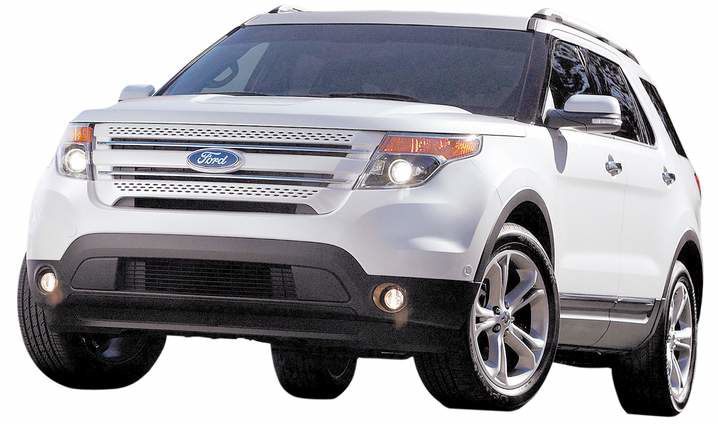The 2011 Explorer — more suited to on-road adventures
Published 4:00 am Sunday, January 2, 2011

- The 2011 Ford Explorer reaches out to families with fuel efficiency, safety features, and seating.
LOS ANGELES — Confronted with rock-strewn hills, or pavement that is flat, straight and most likely located in Illinois, drivers of vehicles that easily switch between two- and four-wheel drive should know which button to choose.
But with its completely redesigned 2011 Explorer, Ford has simplified the translation of 4×4 settings with a knob.
Trending
Conveniently located near the driver’s right elbow and outfitted with symbols for snow, mud and sand that require absolutely no understanding of the English language, this knob is emblematic of Ford’s entirely updated sport utility vehicle.
The Explorer’s new Terrain Management System exemplifies a new Explorer philosophy that is sophisticated and technology-oriented — one that is off-road capable but ultimately biased toward the street.
Powered by a 3.5-liter V-6, the new version comes with a 25 percent improvement in fuel economy over the 2010 version, up to 25 miles per gallon on the highway. Seven seats are now standard instead of being offered as a factory option and at additional expense.
And there are innovative safety features, including two industry firsts: inflatable seatbelts for the middle row of passengers, and a system that corrects course on this large utility vehicle should it careen into a curve at too high a speed and start an unintended detour off-road.
Still, for all its advancements, I found the Explorer slightly wanting.
Driving the Explorer for a day last week between the paved urban sprawl of San Diego and the dirt trails of the Lions, Tigers and Bears animal sanctuary in nearby Alpine, I saw Ford’s intentions clearly. The utility of its new Explorer is more street-oriented than its predecessor, the better to meet customers’ demand for a less trucklike driving experience.
Trending
Ford’s research showed that only 17 percent of Explorer drivers ever wheel their rides into the wild. And for those who do, Ford has made things Neanderthal easy. Driver see snow: Turn terrain management knob to snow. Keep wheels on road. Driver see sand: Turn terrain management knob to sand. Keep wheels moving. Driver see cliff: Press hill descent control button in center of terrain management knob. Pray for safe landing.
Terrain and handling
The Explorer can travel up hill and down dale, as long as the terrain isn’t radically steep or gnarly. It can still ford a stream, if the water doesn’t wash up much higher than its nine inches of ground clearance. And it can tow as much as 5,000 pounds of refrigerators, dirt bikes or just plain dirt, but it is no longer capable of climbing rocks. For that, the 2011 Jeep Grand Cherokee is a better bet.
The 2011 Explorer lost 95 pounds in its redesign, with key areas in its unibody construction made from light-weight boron steel. Still, the Limited version that I was testing weighs almost 4,700 pounds.
Considering it also has almost enough seating for a soccer team, its handling wasn’t like helming a bus. Using the Audi Q7 as its guide, the Explorer has a quieter, more refined ride feel than its predecessor, with a light touch for steering and chassis dynamics that weren’t exactly nimble though they certainly defied its hulk.
Aesthetically, the interior is simple without being finished to a state of true elegance. Its dashboard is trimmed in soft “pleather” with rounded edges, and its center console is shiny piano black that’s pretty until it’s smeared with fingerprints. At least it is uncluttered, since many of the controls for the Explorer are operated through a touch screen or by voice.
With its Explorer, as with many of the models it’s released in the last year, Ford demonstrates an embrace of technology, not only in the driving dynamics of the vehicle but its cockpit.
The 2011 version marks the debut of several Silicon Valley tricks, including the introduction of Wi-Fi capability and an improved voice command system.
Drivers who possess a USB mobile broadband card for their laptops can plug it in to the car’s media hub, enabling Internet access akin to that at a Starbucks. Using one of the vehicle’s two USB ports, five individual handhelds can connect to the cloud at the same time. So much for family time. Gone are the days of getting carsick doing crossword puzzles, or staring out the window, repeatedly asking, “Are we there yet?”
Nuance, a software program that operates the navigation, stereo, phone and climate controls with voice commands, can interpret impolite orders like “I’m hungry” and even decipher — and adapt to — different accents.
Operated by touch or voice, Ford’s LCD-screen communications system worked flawlessly during demonstrations and for the first half of my drive. On a return to San Diego after mild off-roading, however, this high-tech wizardry temporarily failed.
After I fired up the SUV with its push-button ignition, the center-console screen didn’t immediately go to Nav but displayed a message that said its Microsoft-powered SYNC program was updating software — something it continued to do for several minutes.
Once I was able to program in my destination, it stalled halfway into computing the route — until the Explorer was powered down, and I exited the vehicle, shut the door, re-entered and started it back up, at which point it worked just fine.
Ultimately, the greatest outdoor adventure in the new Ford Explorer is light off-roading and inside its four doors.
2011 Ford Explorer Limited 4WD
Base price: $39,190As tested: $45,415
Type: Seven-seat sport utility vehicle.
Engine: Sequential multiport fuel injection, 3.5-liter, Ti-VCT V-6, DOHC, four valves per cylinder, six-speed automatic.
Mileage: 17 mpg city, 25 mpg highway.








